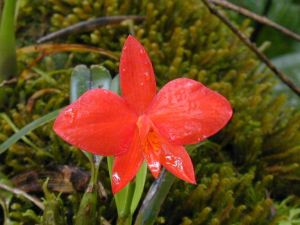(Created page with "thumb|''Sophronitis coccinea'' (not my photo) '''Common Name:''' The Scarlet Sophronitis<br /> '''Scented:''' no<br /> '''Light Requirements:''' partial shade<br /> '''Temperature Requirements:''' intermediate to cool<br /> '''Blooms:''' spring<br /> '''Flower Size:''' 3 to 7cm<br /> '''Synonyms:''' *Cattleya ''coccinea'' Lindley 1836; Cattleya ''coccinea var. rossiteriana'' (Barb.Rodr.) Van den Berg 2008; Cattleya ''grandiflora'' [Lin...") |
No edit summary |
||
| Line 1: | Line 1: | ||
[[File: | [[File: Sophronitis_coccinea.jpg|thumb|''Sophronitis coccinea'' (not my photo)]] | ||
'''Common Name:''' The Scarlet Sophronitis<br /> | '''Common Name:''' The Scarlet Sophronitis<br /> | ||
Latest revision as of 21:09, 11 June 2024

Common Name: The Scarlet Sophronitis
Scented: no
Light Requirements: partial shade
Temperature Requirements: intermediate to cool
Blooms: spring
Flower Size: 3 to 7cm
Synonyms: *Cattleya coccinea Lindley 1836; Cattleya coccinea var. rossiteriana (Barb.Rodr.) Van den Berg 2008; Cattleya grandiflora [Lindley]Beer 1854; Eunannos coccinea [Lindley] Porto & Brade 1933; Hadrolaelia coccinea ( Lindl. ) Chiron & V.P.Castro 2002; Sophronia coccinea Kuntze 1891; Sophronia militaris Kuntze 1891; Sophronitis coccinea f. rossiteriana [Barb. Rodr.] Pabst & Dungs. 1972; Sophronitis coccinea var barboleta hort.; Sophronitis coccinea var grandiflora hort.; Sophronitis coccinea var insolaris hort; Sophronitis coccinea var militaris hort; Sophronitis coccinea var rossiteriana Hort; Sophronitis grandiflora Lindley 1837; Sophronitis lowii [Hort.]Curtis 1923; Sophronitis militaris Rchb.f 1861; Sophronitis rossiteriana Barb. Rodr. 1877
A miniature sized, cool to warm growing epiphyte or sometimes lithophyte from southeastern Brazil [Rio de Janiero to Rio do Sul States] mainly in the tropical coastal forest [mata atlantica] that covers the coastal mountain range [Serra do Mar] at elevations of 650 to 1670 meters in warm to cool montane forests on slender moss covered trees or on rocks in sheltered or exposed conditions, with fusiform, closely packed pseudobulbs with a single elliptic, erect, coriaceous, 2 1/2" leaf with the midrib being a red line, that blooms in spring and again sometimes in the fall on an apical, erect to arching, 1.2" to 3" [3 to 7.5 cm] long inflorescence with a single non-fragrant, long-lasting flower.
Good ventilation, cool to cold temperatures, bright light and a wet environment with regular fertilizer year round will keep this minature plant thriving. This specfies in it's range has an average summer temperature of 80 degrees and a winter average of 45 degrees.